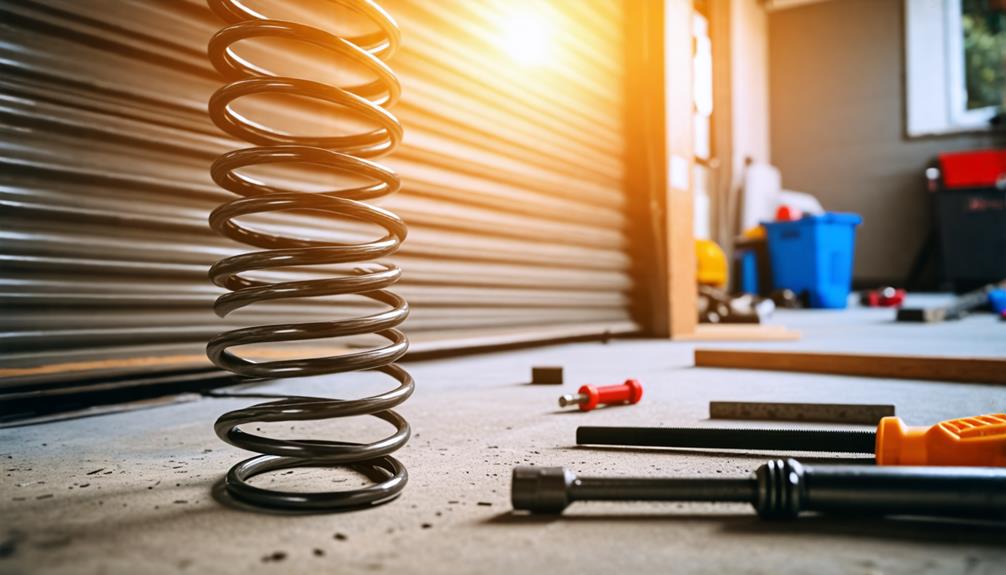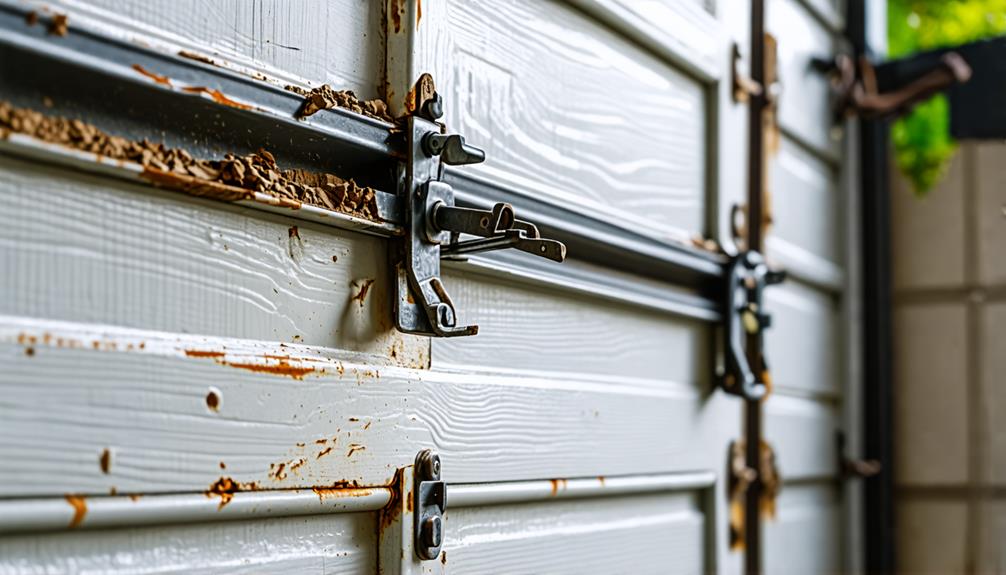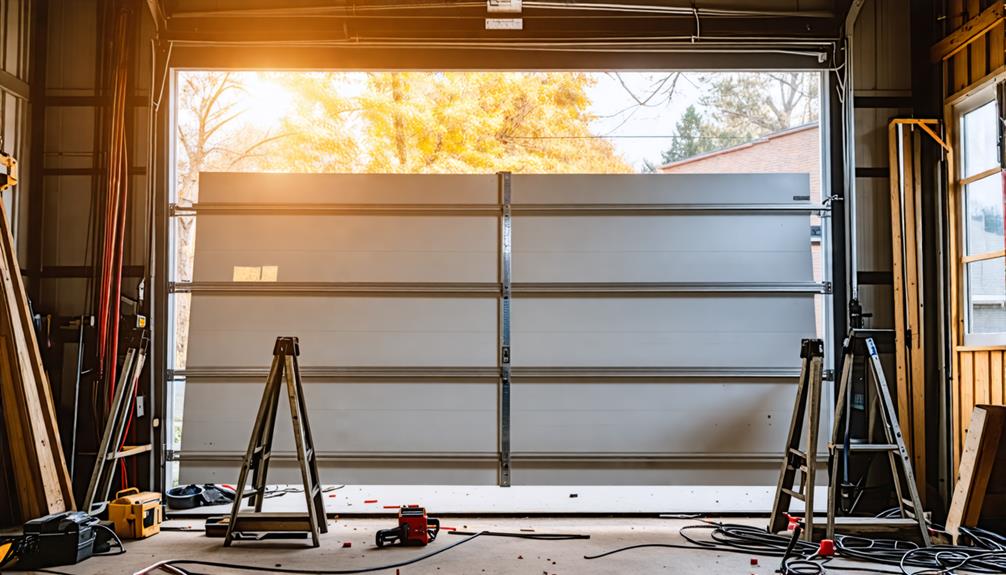
What Is the Toughest Part of Installing a Garage Door?
The most challenging aspect of installing a garage door is certainly the spring tension adjustment. This task requires precise measurements, specialized tools, and an understanding of complex calculations to balance the door's weight properly. You'll need to navigate significant safety hazards, as torsion springs can exert forces up to 300 pounds when released unexpectedly. Achieving proper track alignment and overcoming leveling challenges are also formidable tasks, demanding exact measurements and careful adjustments. Balancing weight distribution through precise cable tension and perfectly level tracks is essential for smooth operation. Mastering these intricate details will guarantee a properly functioning garage door system.
Spring Tension Adjustment

When adjusting spring tension on your garage door, you'll need to be acutely aware of the precise measurements required, as even small deviations can drastically impact the door's balance and operation.
This is why many choose to hire professional garage door technicians who've the qualifications and expertise to handle such a delicate task. The process involves serious safety hazards, including the risk of sudden spring release or door collapse, which can cause severe injury if proper precautions aren't taken.
They use specialized tools such as winding bars, vise grips, and a tension meter, which are designed specifically for handling high-tension garage door springs.
Precise Measurement Requirements
Precision is paramount when adjusting the spring tension of your garage door. You'll need to calculate the exact force required to balance the door's weight, which involves measuring the door's dimensions and weight accurately. Begin by determining the door's height, width, and thickness using a reliable tape measure.
Next, you'll need to weigh the door, which may require specialized equipment or professional assistance. Once you have these measurements, you can calculate the appropriate spring tension using industry-specific formulas.
How do you guarantee your measurements are precise? Use calibrated tools and double-check your readings. Remember, even small discrepancies can lead to significant issues with door operation. When measuring the door's weight, consider factors such as insulation, windows, or decorative elements that may affect the overall mass.
Are you working with extension springs or torsion springs? Each type requires different measurement techniques and calculations. For torsion springs, you'll need to measure the wire size, inside diameter, and length. Extension springs require measuring the overall length and stretched length. Don't forget to account for the weight of hardware components, such as tracks and rollers, in your calculations.
Safety Hazards Involved
Before you begin adjusting garage door spring tension, it's essential to understand the significant safety hazards involved. The torsion springs, which counterbalance the door's weight, store an immense amount of energy. If mishandled, they can cause severe injury or even death. Are you aware that these springs can exert forces of up to 300 pounds? This tension, when released unexpectedly, can result in devastating consequences.
When working with torsion springs, you'll need specialized tools and knowledge. Have you considered the risks of using improper equipment? Winding bars, for instance, must be of the correct size and strength to withstand the spring's force. Attempting to adjust the tension without the right tools can lead to the bar slipping, potentially causing facial injuries or worse. Moreover, the process requires precision and diligence. Rushing through the adjustment or making miscalculations can result in an improperly balanced door, leading to operational issues and safety concerns. Remember, even experienced professionals approach this task with caution. If you're unsure about your ability to safely handle spring tension adjustment, it's crucial to consult a professional garage door technician.
Specialized Tools Needed
To safely adjust garage door spring tension, you'll need a specific set of tools. The most indispensable implement is a set of specialized winding bars, which are solid steel rods designed to fit into the winding cone holes of torsion springs. These bars must be the correct diameter and length to provide adequate leverage and safety during the adjustment process.
You'll also require an adjustable wrench or socket set to loosen and tighten the set screws on the winding cones. A sturdy ladder is essential for reaching the spring assembly, which is typically mounted above the garage door. Don't forget safety gear: heavy-duty work gloves to protect your hands and safety glasses to shield your eyes from potential debris.
For precise adjustments, you might need a spring scale to measure the door's weight and balance. Some professionals use a torque wrench to maintain consistent tension across multiple springs. Have you considered using a tension gauge? This specialized tool can help you accurately measure spring tension without the need for manual calculations. Remember, improper use of these tools can lead to serious injury, so if you're unsure, it's best to consult a professional.
Benefits

When you install a new garage door, you'll reap numerous benefits that extend beyond mere functionality. Not only does it enhance your home's security, but with the professional installation and customization service offered by Future Garage Door, you can substantially boost your home's curb appeal.
Additionally, modern garage doors often come with improved insulation properties, which can lead to notable energy efficiency gains, potentially lowering your heating and cooling costs over time. The potential increase in your overall property value is yet another advantage of installing a new garage door.
Improved Home Security
A new garage door greatly improves your home's security. Modern garage doors are designed with advanced locking mechanisms and sturdy materials that make them significantly more difficult to breach than older models. You'll find that many new doors incorporate features like automatic locking systems, which engage as soon as the door closes, preventing would-be intruders from manually lifting the door.
Have you considered the role of your garage door's opener in security? Today's smart openers offer rolling code technology, which changes the access code each time you use the remote, thwarting potential code-grabbing devices. Additionally, you can integrate these openers with your home security system, allowing you to monitor and control your garage door remotely. This means you'll never have to worry about whether you've left the door open again.
When selecting a new garage door, pay attention to the material. Steel doors, particularly those with insulated cores, provide excellent security without sacrificing aesthetic appeal. Remember, a secure garage door not only protects your vehicles but also prevents access to the rest of your home, making it an essential component of your overall home security strategy.
Enhanced Curb Appeal
From the moment it's installed, a new garage door can dramatically transform your home's exterior appearance. You'll immediately notice how this substantial feature enhances your property's curb appeal, often accounting for up to 30% of your home's façade.
When selecting a new garage door, consider styles that complement your home's architectural design, whether it's contemporary, traditional, or somewhere in between. Options like carriage house doors, sleek aluminum and glass panels, or classic raised panel designs can profoundly impact your home's overall aesthetic.
Color choice is equally imperative. You might opt for a bold statement color to create a focal point or choose a shade that harmonizes with your home's existing color scheme. Don't overlook the importance of windows in your garage door design. They not only add visual interest but also allow natural light into your garage space.
Additionally, hardware selections, such as decorative handles and hinges, can provide the finishing touches that elevate your door's appearance. Remember, investing in a high-quality, visually appealing garage door not only enhances your home's look but can also increase its resale value. How will you customize your garage door to maximize its curb appeal?
Increased Property Value
Installing a new garage door isn't just about improving your home's appearance; it's a smart investment that can considerably boost your property value. When potential buyers evaluate a home, they often scrutinize the garage door's condition, functionality, and style. A modern, well-installed garage door can greatly increase your home's market value, sometimes by as much as 4% according to real estate experts.
You'll find that a new garage door enhances your home's energy efficiency, potentially lowering utility costs and further increasing its appeal to prospective buyers. Furthermore, it improves security, which is an essential factor for many homeowners.
Have you considered the impact of material choice on value? Steel doors, for instance, offer durability and low maintenance, while wood doors provide a classic aesthetic that can elevate your home's overall look. Additionally, smart garage door openers with advanced features like smartphone integration can add a tech-savvy edge to your property.
Energy Efficiency Gains
While many homeowners focus on the aesthetic benefits of a new garage door, they often overlook the significant energy efficiency gains it can provide. Modern garage doors are designed with energy conservation in mind, incorporating advanced insulation materials and improved sealing techniques.
You'll find that these doors can substantially reduce heat transfer between your garage and the outdoors, helping to maintain a more consistent temperature in both your garage and adjacent living spaces.
When selecting a new garage door, pay attention to its R-value, which measures insulation effectiveness. Higher R-values indicate better insulation properties. Have you considered the impact of your garage door's material on energy efficiency? Steel and aluminum doors with polyurethane foam cores offer excellent insulation, while wood doors may require additional weatherstripping to achieve similar results.
Don't forget about the importance of proper installation and regular maintenance. Guarantee that your new door is correctly aligned and sealed to maximize its energy-saving potential. By investing in an energy-efficient garage door, you're not only reducing your carbon footprint but also potentially lowering your heating and cooling costs. How much could you save on your energy bills with this upgrade?
Proper Track Alignment

When installing a garage door, proper track alignment is imperative for smooth operation and longevity. You'll need to take precise measurements and overcome leveling challenges to ensure the tracks are perfectly parallel and plumb. Balancing weight distribution is essential, as uneven tracks can lead to premature wear, noise issues, and potential safety hazards.
| Track Alignment Factor | Importance | Potential Issues if Neglected |
|---|---|---|
| Precise Measurements | High | Binding, jerky movement |
| Leveling | Critical | Door misalignment, gaps |
| Parallel Tracks | Essential | Uneven wear, noise |
| Plumb Installation | Indispensable | Operational strain, jamming |
| Weight Distribution | Paramount | Imbalance, premature failure |
Precise Measurements Required
For a smooth-operating garage door, precise measurements and proper track alignment are essential. You'll need to meticulously measure the door opening's width and height, guaranteeing you account for any irregularities in the floor or framing. These measurements will dictate the size of your door panels and the placement of your vertical tracks.
When installing the tracks, you must maintain a consistent distance from the door's edge, typically about 3/8 inch. This gap allows for proper sealing and prevents binding. You'll also need to ascertain the tracks are plumb (perfectly vertical) using a level. Any deviation can cause the door to operate inefficiently or even fail prematurely.
The horizontal tracks require equal attention to detail. They should have a slight upward slope, usually about 1/8 inch per foot, to facilitate smooth closure. How do you achieve this precision? Use a laser level or string line to mark your reference points. Remember, the tracks must be parallel to each other and perpendicular to the vertical tracks. Are your measurements off by even a fraction of an inch? This can lead to misalignment, causing undue stress on the door's components and potentially shortening its lifespan.
Leveling Challenges
Achieving proper track alignment often presents significant leveling challenges. When installing a garage door, you'll need to ensure that both tracks are perfectly level and parallel to each other. This task requires precision and patience, as even slight misalignments can lead to operational issues and premature wear on the door components.
To tackle this challenge, you'll need to use a level and carefully adjust the brackets that hold the tracks in place. Are your tracks plumb and square? This is imperative for smooth operation. You may need to shim the tracks or make minor adjustments to the mounting hardware to achieve the desired alignment. Remember, the tracks must be the same height on both sides and equidistant from the door opening.
Pay close attention to the vertical tracks, guaranteeing they're perfectly straight and parallel to the door jambs. The horizontal tracks should have a slight slope towards the back of the garage to facilitate proper door closure. How much slope? Typically, you'll aim for about 1/8 inch of drop for every 12 inches of track. This precise alignment is essential for ideal door balance and longevity.
Balancing Weight Distribution
The balancing act of weight distribution is essential for proper garage door operation. When installing a garage door, you'll need to make sure that the weight is evenly distributed across the system. This involves carefully adjusting the springs, cables, and other components to achieve the optimal balance. Have you considered the importance of proper track alignment in this process? It's crucial for smooth operation and longevity of your garage door.
To balance the weight distribution, you'll need to fine-tune the torsion springs or extension springs, depending on your door's configuration. These springs counteract the door's weight, making it easier to open and close. You'll also need to adjust the cable tension, which works in tandem with the springs.
Are your tracks perfectly level and parallel? If not, the door may bind or experience uneven wear over time. Use a level and measuring tape to ensure precise alignment. Don't forget to check the rollers and hinges, as they play a significant role in weight distribution. Remember, a well-balanced garage door should stay in place when manually opened halfway, neither rising nor falling. If it doesn't, further adjustments are necessary.
Frequently Asked Questions
How Long Does a Typical Garage Door Installation Take?
You can expect a typical garage door installation to take 3-5 hours. It'll depend on the door's complexity and your installer's experience. They'll remove the old door, install tracks, springs, and panels, then test everything for smooth operation.
Can I Install a Garage Door Myself or Should I Hire Professionals?
You can install a garage door yourself, but it's a complex task. It's often safer and more efficient to hire professionals. They have the expertise, tools, and experience to guarantee proper installation and functionality.
What Tools Are Necessary for Installing a Garage Door?
You'll need a drill, level, tape measure, wrenches, pliers, and safety glasses. Don't forget a ladder, sawhorses, and clamps. For electrical work, include a voltage tester. A helper is also essential for safe installation.
How Much Does It Cost to Install a New Garage Door?
You'll typically spend $750 to $1,500 for a new garage door installation. Costs vary based on the door's material, size, and style. Don't forget to factor in labor expenses, which can range from $300 to $800.
Are There Specific Building Codes or Permits Required for Garage Door Installation?
You'll likely need permits for garage door installation. Check with your local building department for specific codes and requirements. They'll guide you on necessary permits, safety standards, and inspections to guarantee your installation complies with regulations.





